综合锻炼计划下的远程康复对慢性踝关节不稳患者功能的影响:随机对照试验
IF 2.2
3区 医学
Q1 REHABILITATION
引用次数: 0
摘要
设计:单盲随机对照试验。目的探讨远程运动疗法与临床运动疗法在综合运动方案下对慢性踝关节不稳(CAI)患者运动功能恢复的治疗效果是否存在差异。方法将患者随机分为对照组(CG)和远程康复组(TRG)。实验组接受了为期4周的临床运动康复计划,实验组接受了远程康复应用的指导,随后接受了为期4周的远程康复方案。两组参与者在相同的运动处方框架下接受运动治疗。结果测量,包括功能、疼痛、力量、平衡和自我效能,在基线、4周和8周进行评估。结果共有48名受试者完成了试验。在第4周时,与基线相比,所有结果均有显著改善,表明采用综合运动方案的两种治疗方式均增强了CAI患者的功能。8周后,两组患者的功能均持续改善。值得注意的是,在所有结果中,只有改良步态功效量表(mGES)显示出显著的组效应,CG的mGES高于TRG (P <;4周时为0.001,8周时为P = 0.002)。结论在综合锻炼方案下,远程康复在改善CAI患者运动功能方面的效果与临床运动治疗相当,而在提高自我效能方面仅略低于临床运动治疗。本文章由计算机程序翻译,如有差异,请以英文原文为准。
The effect of tele-rehabilitation under a comprehensive exercise program on the function of patients with chronic ankle instability: A randomized controlled trial
Design
Single-blind randomized controlled trial.
Objective
To investigate whether there is a difference in the therapeutic effect of remote exercise therapy and clinic-based exercise therapy on the recovery of motor function in patients with chronic ankle instability (CAI) under a comprehensive exercise program.
Methods
Participants were randomly assigned to either the control group (CG) or the tele-rehabilitation group (TRG). The CG underwent a 4-week clinic-based exercise rehabilitation program, while the TRG received guidance on using a tele-rehabilitation application followed by a 4-week tele-rehabilitation regimen. The participants in both groups underwent exercise therapy under the same exercise prescription framework. Outcome measures, including functionality, pain, strength, balance, and self-efficacy, were assessed at baseline, 4 weeks, and 8 weeks.
Results
A total of 48 participants completed the trial. At the 4-week mark, all outcomes demonstrated significant improvement compared to baseline, indicating that both treatment modalities utilizing the comprehensive exercise program enhanced the functionality of patients with CAI. By 8 weeks, functional improvements were sustained in both groups. Notably, among all outcomes, only the Modified Gait Efficacy Scale (mGES) revealed a significant group effect, with the CG exhibiting higher mGES than the TRG (P < 0.001 at 4 weeks and P = 0.002 at 8 weeks).
Conclusion
The results suggest that, under a comprehensive exercise program, tele-rehabilitation can achieve outcomes comparable to clinic-based exercise therapy in enhancing motor function in patients with CAI, with only a slight disadvantage in improving self-efficacy compared to clinic-based therapy.
求助全文
通过发布文献求助,成功后即可免费获取论文全文。
去求助
来源期刊

Musculoskeletal Science and Practice
Health Professions-Physical Therapy, Sports Therapy and Rehabilitation
CiteScore
4.10
自引率
8.70%
发文量
152
审稿时长
48 days
期刊介绍:
Musculoskeletal Science & Practice, international journal of musculoskeletal physiotherapy, is a peer-reviewed international journal (previously Manual Therapy), publishing high quality original research, review and Masterclass articles that contribute to improving the clinical understanding of appropriate care processes for musculoskeletal disorders. The journal publishes articles that influence or add to the body of evidence on diagnostic and therapeutic processes, patient centered care, guidelines for musculoskeletal therapeutics and theoretical models that support developments in assessment, diagnosis, clinical reasoning and interventions.
 求助内容:
求助内容: 应助结果提醒方式:
应助结果提醒方式:


